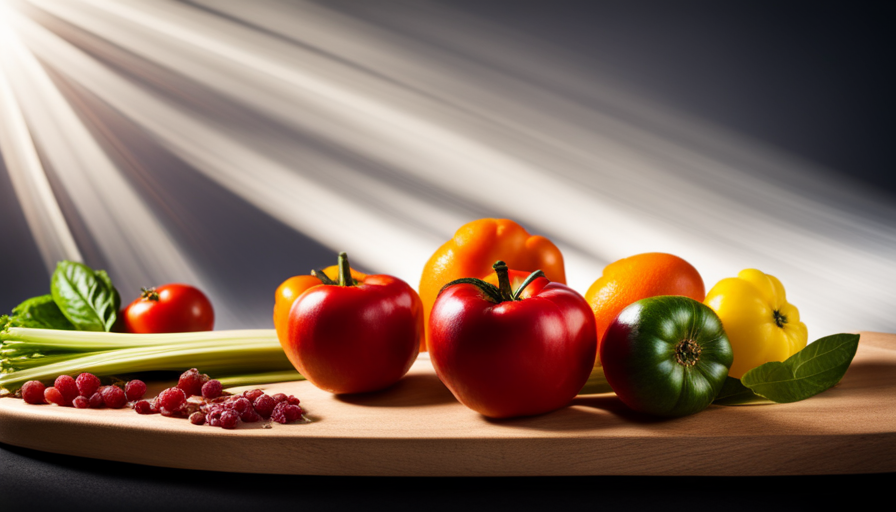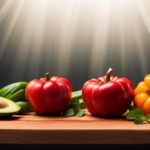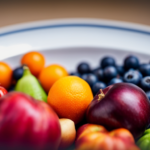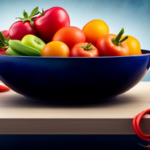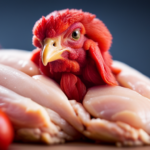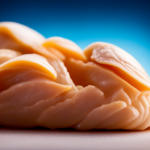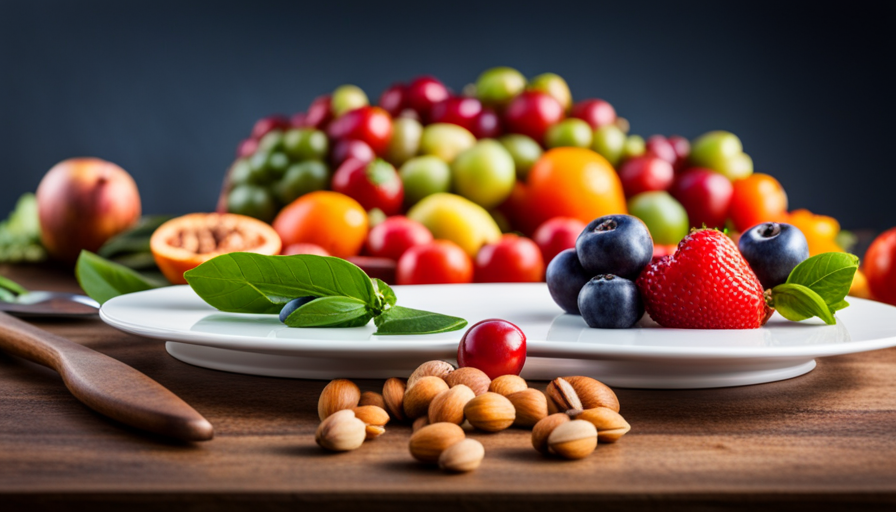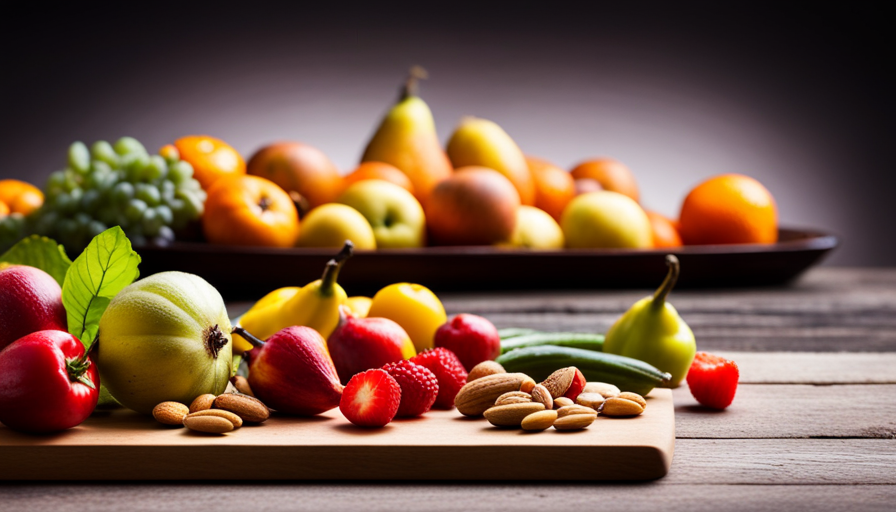Are you feeling unwell? Dealing with a persistent cold or a severe flu? Hold on to your seat because we are about to delve into a controversial topic that could catch you off guard.
Picture this: you’re lying in bed, tissues strewn around you, and a friend suggests munching on some raw fruits and veggies to speed up your recovery. But wait, is raw food really bad for you when you’re sick? Brace yourself for some eye-opening information that might challenge your beliefs.
While raw food enthusiasts tout its countless benefits, there’s a catch when it comes to illness. You see, when you’re feeling under the weather, your body needs all the help it can get. And that’s where cooked food comes in, armed with its arsenal of nutritional benefits.
But before we dive into the details, let’s take a moment to understand the nutritional value of raw food and the digestive challenges it presents during illness. So hang in there, because we’re about to uncover the truth behind this raw food debate.
Key Takeaways
- Raw food can have immune-boosting properties and essential nutrients that can be beneficial when you are sick.
- However, consuming raw food when sick may pose risks due to digestive challenges and a higher risk of foodborne illnesses.
- Proper food handling and hygiene practices, such as washing hands thoroughly and using separate utensils for raw and cooked foods, are crucial when consuming raw food.
- Finding a balance between raw and cooked foods is important for optimal health, as cooked foods are often easier to digest and can enhance nutritional value.
The Benefits of Cooked Food for the Sick
Cooked food can be a lifesaver when you’re feeling sick and in need of some warm, comforting nourishment. When you’re ill, your body needs all the nutrients it can get to help fight off the illness and promote healing.
Cooking methods such as steaming, boiling, and baking can actually help preserve the nutrients in foods, making them more beneficial for your recovery.
One of the main benefits of cooked food for the sick is that it’s easier to digest. Illness can often leave your digestive system weak and sensitive, making it difficult to process raw foods. Cooked foods, on the other hand, are softer and more easily broken down, making them easier for your body to absorb and utilize.
Additionally, certain cooking methods can actually enhance the availability of certain nutrients. For example, cooking tomatoes increases the bioavailability of lycopene, a powerful antioxidant. Steaming vegetables can also help break down tough fibers, making them easier to digest and allowing your body to access the valuable vitamins and minerals they contain.
When you’re sick, opting for cooked food can provide you with the nourishment you need to support your recovery. Cooking methods that preserve nutrients and choosing easy-to-digest foods are essential for promoting healing and giving your body the fuel it needs to bounce back.
So, next time you’re under the weather, reach for some warm, comforting cooked food to help you feel better faster.
The Nutritional Value of Raw Food
Contrasting with cooked meals, the nutritional benefits of consuming raw ingredients are often overlooked. Raw food retains its natural enzymes, vitamins, and minerals, making it a powerhouse of nutrients.
When you’re sick, consuming raw food can provide you with numerous nutritional benefits that can aid in your recovery.
Raw food is packed with essential nutrients that can support your immune system and help fight off infections. It contains a wide range of vitamins, such as vitamin C and vitamin A, which are known for their immune-boosting properties. Additionally, raw food is rich in antioxidants, which can help reduce inflammation and oxidative stress in your body.
Moreover, raw food is easier to digest compared to cooked food. Cooking can destroy some of the natural enzymes present in food, making it harder for your body to break down and absorb nutrients. Raw food, on the other hand, contains active enzymes that aid in digestion and improve nutrient absorption. This can be particularly beneficial when you’re sick and experiencing digestive challenges.
Consuming raw food when you’re sick can provide you with valuable nutritional benefits. Its abundance of vitamins, minerals, and enzymes can support your immune system and aid in your recovery. So, don’t underestimate the power of raw ingredients in promoting your overall health, especially during times of illness.
Digestive Challenges of Raw Food during Illness
When feeling under the weather, it’s important to note that raw ingredients may pose some digestive challenges. This includes a higher risk of foodborne illnesses due to harmful bacteria present in uncooked food. While raw food enthusiasts tout the cooking benefits and nutritional value of raw food, it’s crucial to consider the potential risks, especially when you’re sick.
Cooking food not only enhances its taste and texture but also helps kill harmful bacteria that may be present. When you’re ill, your immune system is already weakened, making it harder for your body to fight off any bacteria that may be present in raw food. This increases the risk of developing foodborne illnesses, which can worsen your symptoms and prolong your recovery.
Additionally, cooking food can make it easier to digest, especially when your digestive system is already compromised due to illness. Heat breaks down the complex structures of food, making it more bioavailable and easier for your body to absorb the essential nutrients it needs to heal.
While raw food may have some cooking benefits and nutritional value, it’s important to consider the potential digestive challenges and increased risk of foodborne illnesses when you’re sick. It’s advisable to prioritize cooked food during this time to ensure your body receives the necessary nutrients and to minimize any further health complications.
Immune-Boosting Properties of Raw Food
Boost your immune system with the natural goodness of fresh, uncooked ingredients, helping your body stay strong and resilient. While there are some challenges of consuming raw food during illness, it’s important to understand the immune-boosting properties that raw food can provide.
Raw food is rich in nutrients, enzymes, and antioxidants that can support your immune system. By consuming fruits, vegetables, and nuts in their raw form, you can maximize the intake of vitamins, minerals, and phytonutrients that are essential for a healthy immune response.
Contrary to some myths, raw food doesn’t weaken your immune system when you’re sick. In fact, it can provide nourishment and aid in your recovery. However, it’s important to consider your specific illness and consult with a healthcare professional to determine the best approach for your condition.
To incorporate immune-boosting recipes into your diet, try making fresh salads with a variety of vegetables, fruits, and leafy greens. You can also enjoy raw smoothies or juices packed with immune-boosting ingredients like ginger, turmeric, and citrus fruits.
Raw food can be a valuable addition to your diet when you’re sick, providing immune-boosting properties and essential nutrients. However, it’s important to be mindful of your individual circumstances and seek guidance from a healthcare professional.
Hygiene and Safety Considerations
Taking proper precautions and following hygiene and safety guidelines is crucial when incorporating fresh and uncooked ingredients into your meals. Raw food can be a nutritious choice, but it also carries a higher risk of causing foodborne illnesses if not handled correctly. To ensure your safety, here are four important considerations to keep in mind:
-
Proper food handling: Wash your hands thoroughly before and after handling raw food. Use separate cutting boards and utensils for raw and cooked foods to avoid cross-contamination. Clean all surfaces and equipment used during food preparation.
-
Fresh and reputable sources: Choose fresh and high-quality ingredients from reputable sources. Inspect fruits, vegetables, and meats for any signs of spoilage or contamination. Avoid consuming raw seafood, eggs, or unpasteurized dairy products, as they pose a higher risk of foodborne illnesses.
-
Temperature control: Keep perishable raw foods refrigerated at or below 40°F (4°C) to prevent the growth of harmful bacteria. When preparing meals, avoid leaving raw ingredients at room temperature for extended periods.
-
Cooking when in doubt: If you’re unsure about the safety of a particular ingredient, it’s best to cook it thoroughly. Cooking kills most bacteria and viruses that may be present, reducing the risk of foodborne illnesses.
By following these guidelines, you can enjoy the benefits of raw food while minimizing the risk of foodborne illnesses caused by improper handling or contamination. Remember, your health is paramount, and taking these precautions ensures a safe and enjoyable dining experience.
The Role of Personal Preference in Food Choices
Your taste buds play a vital role in determining the food choices you make. When it comes to raw food, personal preference can be influenced by various factors, including cultural influences and psychological factors.
Cultural influences on food choices can vary greatly from one person to another. For example, certain cultures may have a tradition of consuming raw seafood or meat, while others may prefer cooked food.
Psychological factors also play a significant role in food preferences. Some individuals may have a preference for raw food due to its perceived health benefits, while others may find it unappetizing or even unsafe.
Additionally, personal experiences and emotions can impact food choices. For instance, someone who has had a negative experience with raw food in the past may be more inclined to choose cooked food when they are sick.
Ultimately, personal preference should be taken into consideration when deciding whether to consume raw food when you are sick. It’s important to listen to your body and make choices that align with your cultural background, psychological factors, and personal experiences.
Expert Opinions on Raw Food and Illness
Contrary to popular belief, experts argue that indulging in raw culinary delights during times of illness can be as risky as walking on thin ice. While raw food advocates claim that it provides numerous health benefits, there is a growing body of evidence suggesting that it may not be the best choice when you’re sick.
-
Expert opinions: Many nutritionists and healthcare professionals caution against consuming raw food when you’re sick. They believe that raw food, particularly raw animal products like sushi or raw eggs, may contain harmful bacteria or parasites that can further compromise your already weakened immune system.
-
Immune system benefits: While raw food enthusiasts argue that consuming raw fruits and vegetables can boost your immune system, experts contend that the benefits do not outweigh the risks when you’re ill. Cooking food can help kill harmful bacteria and parasites, making it safer for consumption.
-
Personalized approach: It’s important to consider your individual circumstances when deciding what to eat while sick. If you have a strong immune system and are confident in the quality and safety of the raw food you consume, it may not pose as much of a risk. However, for individuals with compromised immune systems or during times of illness, it is generally advisable to opt for cooked food to minimize the chances of foodborne illnesses.
While raw food may offer immune system benefits in certain circumstances, it is generally recommended to choose cooked food when you’re sick to reduce the risk of foodborne illnesses.
Listening to Your Body’s Needs
Listening to your body’s needs can be a crucial step in making informed decisions about what to consume during times of illness. When you’re sick, your body is working hard to heal and recover. Raw food can have healing benefits, as it’s packed with essential nutrients and enzymes. However, it’s important to listen to your body and pay attention to what it’s telling you.
Intuitive eating is a concept that encourages you to trust your body’s signals and eat in a way that supports your overall well-being.
If you’re craving raw fruits and vegetables, it may be a sign that your body needs the vitamins and minerals they provide. In this case, incorporating raw food into your diet can be beneficial. However, if you find that raw food is causing digestive discomfort or worsening your symptoms, it may be best to opt for cooked or easily digestible foods.
Additionally, it’s important to consider the specific illness you’re dealing with. Some illnesses may require a softer diet or foods that are easier to digest. In these cases, cooked foods may be more appropriate.
Ultimately, the key is to listen to your body and make choices that support your healing process. By practicing intuitive eating and paying attention to how different foods make you feel, you can make informed decisions about whether raw food is right for you when you’re sick.
Balancing Raw and Cooked Foods for Optimal Health
Listening to your body’s needs is essential when it comes to maintaining good health, especially when you’re sick. However, it’s important to strike a balance between raw and cooked foods for optimal health.
When you’re sick, your body often requires easily digestible foods that are gentle on the digestive system. Raw foods, although packed with nutrients, can be difficult for your body to break down and absorb. Therefore, it might be beneficial to incorporate some cooked foods into your diet.
Cooking certain foods can make them easier to digest and can also enhance their nutritional value. For example, cooking vegetables like carrots or tomatoes increases the availability of certain nutrients, such as beta-carotene and lycopene. Additionally, cooking can help kill harmful bacteria or parasites that may be present in raw foods.
However, it’s important to note that cooking can also lead to the loss of certain heat-sensitive nutrients, such as vitamin C. Therefore, it’s crucial to strike a balance between raw and cooked foods to ensure you’re getting the best of both worlds.
By incorporating a variety of both raw and cooked foods into your diet, you can maximize the benefits of each. Raw foods provide enzymes and antioxidants, while cooked foods offer easier digestion and increased nutrient availability. Striving for this balance can help support your overall health, especially when you’re sick.
Conclusion: Making Informed Choices for Your Well-being
In conclusion, by being mindful of the choices you make and incorporating a variety of nourishing options into your diet, you can create a vibrant and balanced lifestyle that supports your overall well-being.
When it comes to balancing raw and cooked foods, it’s important to consider your individual health needs and preferences. While raw food can provide a plethora of nutrients and enzymes, it may not always be the best option when you’re sick.
When you’re feeling under the weather, your body’s immune system is working hard to fight off the illness. Raw foods can be more difficult for your body to digest and may put additional strain on your already weakened immune system. In these cases, it may be more beneficial to consume cooked foods that are easier to digest and gentle on your system.
However, it’s always important to listen to your body and make informed choices based on your specific needs. If you feel that raw foods are helping you recover or if you have a strong preference for them, it’s okay to include them in your diet in moderation. Ultimately, the key is to find a balance that works for you and supports your well-being.
Remember to consult with a healthcare professional for personalized advice and guidance.
Frequently Asked Questions
Can raw food help boost my immune system when I’m sick?
Raw food can indeed help boost your immune system when you’re sick. It’s packed with essential nutrients, enzymes, and antioxidants that support your body’s defenses. Consuming raw fruits and vegetables, such as citrus fruits, leafy greens, and berries, can provide a rich source of vitamins, minerals, and phytochemicals that promote immunity.
However, it’s important to note that some raw foods may not be suitable for certain individuals, especially those with weakened immune systems or digestive issues. Always consult with a healthcare professional for personalized advice.
Are there any safety concerns or risks associated with consuming raw food while being ill?
When you’re sick, consuming raw food can pose safety concerns and risks. According to a study by the Centers for Disease Control and Prevention, raw foods have been linked to foodborne illnesses, especially in individuals with weakened immune systems.
While raw food may provide some nutritional value and an immune system boost when you’re healthy, it’s important to prioritize safety when you’re ill. Cooking food thoroughly can help reduce the risk of illness and ensure that harmful bacteria are destroyed.
How does the nutritional value of raw food compare to cooked food when it comes to supporting recovery from illness?
Raw food offers numerous nutritional benefits for illness recovery. When comparing raw food to cooked food, raw food often contains higher levels of vitamins, minerals, and enzymes that are essential for healing. The cooking process can lead to nutrient loss, reducing the overall nutritional value of cooked food. Therefore, opting for raw food can provide a greater nutritional boost when it comes to supporting your body’s recovery from illness. Raw food is better for healing compared to cooked food.
Is it possible to find a balance between consuming raw and cooked foods during illness for optimal health?
Finding a balance between raw and cooked foods during illness has its pros and cons. Incorporating raw food into your diet while being sick can offer benefits such as increased nutrient intake and antioxidant support.
Raw fruits and vegetables provide essential vitamins and minerals that can aid in recovery. However, it’s important to consider that some raw foods may be difficult to digest and could potentially harbor harmful bacteria.
It’s recommended to consult with a healthcare professional to determine the best approach for your specific condition.
What are some expert opinions on incorporating raw food into your diet when you’re sick?
When you’re feeling under the weather, incorporating raw food into your diet can be like adding fuel to a fire. Expert opinions suggest that it may be risky rather than beneficial.
Raw foods can be harder to digest and may contain harmful bacteria that can further compromise your immune system. However, it’s important to consider individual circumstances and consult with a healthcare professional for personalized advice. They can provide the best guidance on what’s best for your specific situation.
Can Eating Raw Food Aggravate Leaky Gut Syndrome?
Yes, eating raw food can aggravate leaky gut syndrome. Raw foods like fruits, vegetables, and uncooked grains may be difficult for some people with leaky gut to digest. Cooking can break down the fibers and make them more easily digestible for those with digestive issues. Always consult a healthcare professional for dietary advice.
Conclusion
In conclusion, when you’re sick, it’s important to consider the benefits of cooked food. Cooked food provides easier digestion and absorption of nutrients, which can be especially beneficial when your body is already weakened.
However, it’s also important to acknowledge the nutritional value and immune-boosting properties of raw food. Finding a balance between raw and cooked foods can help optimize your health.
Ultimately, listening to your body’s needs and making informed choices is key to promoting your well-being.

